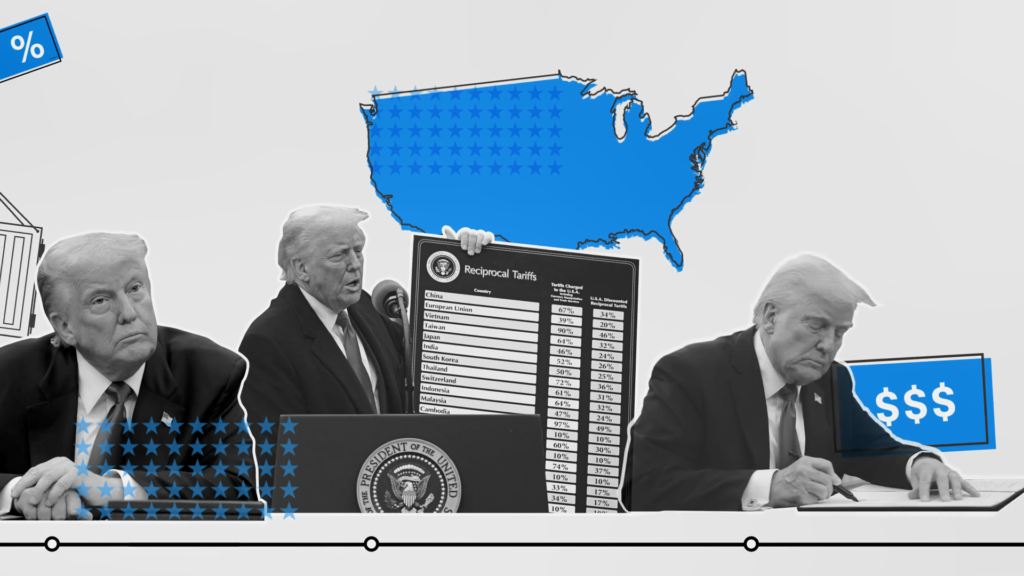The Trump administration’s approach to global trade marked a stark departure from decades of U.S. policy. Central to that shift was the aggressive use of tariffs—taxes on imported goods—as a tool to protect American industries and challenge trade imbalances. This bold strategy sparked trade wars, rattled global markets, and left a legacy still influencing U.S. economic policy today.
In this article, we walk through the Trump tariff timeline, breaking down the most significant events that reshaped global trade from 2018 to 2021—and beyond.
Understanding Tariffs and Trade Wars
What Are Tariffs?
Tariffs are taxes imposed by a government on goods imported from other countries. Their purpose can range from protecting domestic industries to punishing unfair trade practices. While tariffs can help local producers, they often raise prices for consumers and strain international relationships.
Trump’s “America First” Economic Strategy
Donald Trump’s presidency marked a shift toward economic nationalism. Under his “America First” banner, Trump prioritized reducing trade deficits, reviving American manufacturing, and confronting countries—particularly China—that he accused of exploiting the global trading system. Tariffs became the cornerstone of this agenda.
Trump Tariff Timeline – A Year-by-Year Breakdown
2018 – The Tariff Wars Begin
The Trump tariff timeline officially kicked off in March 2018 with tariffs on steel (25%) and aluminum (10%) under Section 232, citing national security concerns. The tariffs applied to key U.S. allies like Canada, Mexico, and the European Union—triggering swift retaliation.
Later that year, the U.S. imposed the first wave of tariffs on Chinese goods, targeting $50 billion worth of imports in response to alleged intellectual property theft and unfair trade practices. China responded with its tariffs, igniting a full-scale trade war.
2019 – Escalation with China and Phase One Trade Talks
The trade war intensified in 2019. The Trump administration announced tariffs on nearly $300 billion more in Chinese goods, affecting everything from electronics to apparel. This prompted another round of Chinese retaliation, hitting American agriculture particularly hard.
In December, after months of tense negotiations, the U.S. and China reached a Phase One trade deal. While it reduced some tariffs and included Chinese commitments to purchase U.S. goods, most tariffs remained in place.
2020 – COVID-19 and Trade Policy on Pause
As the COVID-19 pandemic disrupted the global economy, the Trump administration shifted its focus to public health and emergency economic measures. While no major new tariffs were announced, existing duties stayed in place. The global supply chain chaos, however, underscored the vulnerabilities Trump had aimed to address.
2021 – Transition to Biden Administration
President Joe Biden inherited a complicated trade landscape. While he criticized some of Trump’s tariff decisions, he chose to maintain many of them, especially those targeting China, pending a broader review of U.S. trade strategy. Thus, the Trump tariff timeline continues to influence economic decisions today.
Global Reactions to Trump’s Tariff Policies
Responses from Key Trade Partners
Trump’s tariff strategy provoked a backlash from longtime allies. The EU, Canada, and Mexico all imposed retaliatory tariffs on American goods ranging from bourbon to motorcycles. China, meanwhile, imposed duties on U.S. agricultural exports, prompting the Trump administration to issue billions in subsidies to American farmers.
Several countries challenged U.S. tariffs at the World Trade Organization (WTO), accusing the administration of violating international trade rules.
Impact on U.S. Diplomacy and Alliances
Trump’s unilateral trade actions strained relationships with allies. The decision to abandon the Trans-Pacific Partnership (TPP) and renegotiate NAFTA (now the USMCA) reflected his administration’s broader skepticism toward multilateral trade agreements. While some praised his tough stance, others saw it as damaging to U.S. credibility.
Economic Impact of the Trump Tariff Timeline
Effect on American Industries and Consumers
While some industries—like U.S. steel and aluminum—benefited from protectionist tariffs, others suffered. U.S. manufacturers relying on imported materials faced higher costs, and consumers paid more for goods ranging from washing machines to electronics.
Studies suggest the tariffs led to billions in additional costs for U.S. businesses and households, with minimal evidence of long-term industrial revival.
Job Creation vs. Job Loss
Though tariffs were intended to protect American jobs, the economic picture is mixed. Some jobs were preserved in targeted industries, but others were lost due to rising production costs and reduced exports. A 2019 study from the Federal Reserve estimated the net effect of the trade war was a reduction in U.S. employment.
U.S.–China Trade Balance and Strategic Outcomes
One of Trump’s key goals was reducing the U.S. trade deficit with China. While the Phase One deal led to some increase in Chinese purchases, the trade balance remained largely unchanged. Moreover, the tariffs pushed companies to diversify supply chains, accelerating a trend of moving manufacturing out of China—but not necessarily back to the U.S.
Lessons Learned from the Trump Tariff Timeline
Did Tariffs Achieve Their Goals?
The Trump tariff timeline is a case study of economic disruption. While the tariffs raised awareness about trade imbalances and supply chain vulnerabilities, they fell short of achieving many long-term goals. U.S. manufacturing showed limited revival, and trade deficits remained stubbornly high.
The Future of U.S. Trade Policy
The Biden administration has adopted a more cautious tone but continues to use tariffs selectively—particularly as a strategic tool in dealings with China. Future leaders may take cues from the Trump era, using tariffs not only for economic reasons but also for geopolitical leverage.
Conclusion
The Trump tariff timeline marked a transformative chapter in U.S. trade policy. By upending traditional alliances, confronting global rivals, and embracing economic nationalism, Donald Trump redefined America’s role in the global marketplace. Whether viewed as bold leadership or reckless disruption, the effects of his tariff strategy are still being felt.
As global trade continues to evolve, understanding this timeline is essential for grasping where we’ve been—and where we may be headed.
Don’t Miss Out! Get the Latest News, Tips, and Updates from Us!
